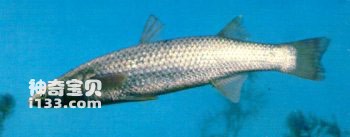Liza haematocheila belongs to the order Mililiformes, the family Mililiidae, and the genus Haematocheila. Commonly known as: tide mullet, red-eyed mullet. English name: Soiuy, Redeye mullet.
The body is like a mullet, cylindrical, with a flat front end and a flat tail side. The head is short and wide, the front end is flat, the snout is short and blunt, and the mouth is sub-lower, in the shape of a "human". The upper jaw is slightly longer than the lower jaw. The upper jaw curves downward sharply at the corner of the mouth, and the rear end is significantly exposed outside the preorbital bone. There is a protrusion at the front of the lower jaw that fits into the depression of the upper jaw. There are villous denticles on the edges of the upper and lower jaws. The eyes are small and slightly red; the fat eyelids are underdeveloped and only exist on the edges of the eyes. The scales are medium, and the entire body is scaled except the snout; axillary scales on the pectoral fins are absent; there is no lateral line. The first dorsal fin is short, composed of 4 hard spines, and is located slightly in front of the middle of the body; the second dorsal fin is at the rear of the body, opposite to the anal fin; the pectoral fin is located higher, close to the posterior edge of the gill cover; the caudal fin is shallowly bifurcated and slightly concave. . The head and back are dark gray-green, the sides of the body are gray, the abdomen is white, and each fin is gray-white.

鮮 is an offshore fish. They mostly live in brackish water along coasts and river estuaries, and can also live in fresh water. Generally, they reach sexual maturity at age 4, and the reproductive season is from April to June. They lay eggs in shallow seas and brackish water areas in river estuaries. Every year in July and August, a large number of juvenile mullet fish move around the shallows of the estuary, feeding on plankton and plant debris.
Widely distributed along the coast and river mouths. It is rich in resources and grows rapidly. In addition, it can live in seawater, brackish water and fresh water. It has a short food chain, easy to feed and is mild in nature. It can coexist harmoniously with other fish and shrimps. It is an excellent saltwater culture species and can also be moved into pure water. Breeding in fresh water. Its meat is tender and fatty, making it a top-quality edible fish.
animal tags:
We created this article in conjunction with AI technology, then made sure it was fact-checked and edited by a Animals Top editor.